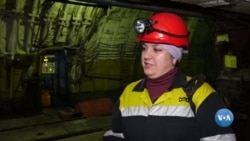ຜູ້ຊາຍຊາວ ຢູເຄຣນ ຈຳນວນຫຼາຍ ຖືກເກນເຂົ້າເປັນທະຫານ, ເຮັດໃຫ້ແມ່ຍິງຊາວ ຢູເຄຣນ ຕ້ອງເຮັດວຽກຢູ່ໃນບໍ່ຖ່ານຫີນທີ່ກວ້າງໃຫຍ່ຂອງປະເທດ. ລີເຊຍ ບາກາເລັດສ໌f ນັກຂ່າວວີໂອເອໄດ້ໄປບໍ່ຖ່ານຫີນດັ່ງກ່າວ ທີ່ຕັ້ງຢູ່ໃນແຖວໜ້າຂອງພາກພື້ນ ດນິໂປຣເປໂຕຣບກ໌ ແລະ ໄດ້ຟັງແມ່ຍິງດັ່ງກ່າວນັ້ນຈຳນວນນຶ່ງ ເລົ່າເລື່ອງລາວຕ່າງໆໃຫ້ຟັງ. ຂົງເຂດທີ່ແນ່ນອນຂອງບໍ່ແຮ່ດັ່ງກ່າວ ແລະຊື່ເຕັມຂອງນັກຂຸດຄົ້ນບໍ່ແຮ່ ແມ່ນບໍ່ໄດ້ຖືກເປີດເຜີຍ ຍ້ອນຄວາມກັງວົນດ້ານຄວາມປອດໄພ.
235 ແມັດເລິກລົງໄປໃນທາງຍ່າງຂອງບໍ່ແຮ່ແຫ່ງນີ້, ແມ່ຍິງຊາວ ຢູເຄຣນ ຫຼາຍຄົນ ແມ່ນກຳລັງເລີ້ມເຂົ້າມາເຮັດອາຊີບໃໝ່.
ນາງ ໂອເລນາ ຈະພົບກັບບັນດານັກຂຸດຄົ້ນບໍ່ແຮ່. ນາງຈະເອົາຄົນ ແລະ ສິນຄ້າຂຶ້ນ ແລະລົງ.
ນາງ ໂອເລນາ ພະນັກງານບໍ່ແຮ່ກ່າວວ່າ “ຂ້ອຍໄດ້ອ່ານໂຄສະນາທີ່ເວົ້າວ່າ ຕ້ອງການກຳມະກອນ. ຂ້ອຍໄດ້ໂທຫາ ແລະ ກໍໄດ້ເຂົ້າເຮັດວຽກ.”
ນາງ ໂອເລນາ ໄດ້ເຮັດວຽກຢູ່ທີ່ນີ້ມາປີເຄິ່ງແລ້ວ.
ນາງ ໂອເລນາ ກ່າວວ່າ “ເພື່ອໃຫ້ກຳລັງໃຈຕົນເອງ ແລະ ນັກຂຸດຄົ້ນບໍ່ແຮ່ຄົນອື່ນໆ, ຂ້ອຍໄດ້ແຕ້ມຮູບກາຕູນຕາຫຼົກ. ເວລາທີ່ນັກຂຸດຄົ້ນບໍ່ແຮ່ທີ່ເມື່ອຍກັບເມືອບ້ານຈາກການເຮັດວຽກ, ເຂົາເຈົ້າຈະແນມເບິ່ງມັນ ແລະ ທຸກຄົນກໍເລີ່ມຍິ້ມ.”
ຈາກບ່ອນທີ່ລິບປ່ອຍໃຫ້ນາງ ນາສເຕຍ ລົງ, ລາວໄດ້ຍ່າງເລິກເຂົ້າໄປໃນອຸໂມງເພື່ອໄປຫາບ່ອນເຮັດວຽກຂອງລາວ.
ນາງເປັນຄົນຂັບລົດລາງ ທີ່ຂົນສົ່ງນັກຂຸດຄົ້ນບໍ່ແຮ່ເລິກລົງໄປໃນບໍ່ແຮ່.
ນາງ ນາສເຕຍ ກ່າວວ່າ “ພວກພີ່ນ້ອງຂອງຂ້ອຍພາກັນຕົກໃຈ ເພາະວ່າແຕ່ກ່ອນມີແຕ່ຜູ້ຊາຍທີ່ເຮັດວຽກຢູ່ໃຕ້ດິນ. ແຕ່ດ້ວຍສະຖານະການໃນປະເທດ, ພວກເຮົາຈະຊ່ວຍເຫຼືອກັນ ໃຫ້ຫຼາຍເທົ່າທີ່ຈະຫຼາຍໄດ້.”
ການບຸກລຸກເຕັມອັດຕາຂອງ ຣັດເຊຍ ໄດ້ກໍ່ໃຫ້ເກີດການຂາດເຂີນແຮງງານໃນບໍ່ແຮ່ຂອງ ຢູເຄຣນ, ໃນຂະນະທີ່ຜູ້ຊາຍຫຼາຍຄົນຖືກເກນເຂົ້າໄປເປັນທະຫານ. ບໍລິສັດໄຟຟ້າເອກະຊົນ DTEK, ເຊິ່ງເປັນເຈົ້າຂອງບໍ່ແຮ່ໃນພາກພື້ນ ດນິໂປຣເປໂຕຣບກ໌ ນັ້ນ, ກໍໄດ້ປະເຊີນກັບການຂາດເຂີນແຮງງານຢ່າງຫຼວງຫຼາຍ.
ທ່ານ ເຢັບເຮັນ ຫົວໜ້າວິສະວະກອນ ກ່າວວ່າ “ກ່ອນປີ 2022, ມີປະມານ 20,000 ຄົນ ໄດ້ເຮັດວຽກຢູ່ບໍ່ແຮ່ DTEK. ປັດຈຸບັນນີ້, 3,500 ຄົນແມ່ນຢູ່ໃນກອງກຳລັງຕິດອາວຸດຂອງ ຢູເຄຣນ. ນີ້ແມ່ນຕົວເລກຂອງພະນັກງານທີ່ເທົ່າກັບທັງໝົດບໍ່ແຮ່ແຫ່ງນຶ່ງ.”
ບໍລິສັດດັ່ງກ່າວ ໄດ້ເລີ່ມວ່າຈ້າງແມ່ຍິງໃນລະດູຮ້ອນປີ 2022, ຫຼັງຈາກສະພາແຫ່ງຊາດ ຢູເຄຣນ ໄດ້ຢຸດການຫ້າມແມ່ຍິງຈາກການເຮັດວຽກໜັກ ແລະ ຢູ່ໃຕ້ດິນທີ່ເປັນອັນຕະລາຍ.
ທ່ານ ເຢັບເຮັນ ກ່າວວ່າ “ພວກເຮົາໄດ້ວິເຄາະວຽກງານທີ່ສາມາດດຶງດູດແມ່ຍິງ, ວິທີທີ່ຈະຝຶກສອນໃຫ້ພວກເຂົາເຈົ້າ. ມັນໃຊ້ເວລາປະມານ 3 ເດືອນທີ່ຈະໄດ້ຜູ້ທີ່ມີຄວາມສາມາດພິເສດກຸ່ມໃໝ່. ພ້ອມກັນນັ້ນ, ພວກເຮົາກໍໄດ້ຕັ້ງເປົ້າທີ່ຈະເອົາແມ່ຍິງເຂົ້າມາເຮັດໃນວຽກທີ່ໜັກຕໍ່ຮ່າງກາຍ.”
ແມ່ຍິງຈະບໍລິຫານຫົນທາງ, ຂົນສົ່ງນັກຂຸດຄົ້ນບໍ່ແຮ່ໄປຍັງສະຖານທີ່ເຮັດວຽກຂອງພວກເຂົາເຈົ້າ, ຄວບຄຸມຄຸນນະພາບອາກາດ, ແລະ ທຳການສ້ອມແປງຕ່າງໆ, ຄືນາງ ໂອເລນາ.
ນາງ ໂອເລນາ ກ່າວວ່າ “ມື້ນີ້, ພວກເຮົາໄດ້ປ່ຽນລໍ້ຢູ່ລົດຂົນສົ່ງ. ພວກເຮົາໄດ້ເອົາອັນນີ້ອອກ.. ເຈົ້າເຫັນສະພາບມັນບໍ່ ແລະ ເອົາອັນໃໝ່ໃສ່.”
ໃນຂະນະທີ່ແມ່ຍິງເຂົ້າມາເຮັດວຽກງານດັ່ງກ່າວນີ້, ຜູ້ຊາຍແມ່ນໄດ້ຖືກຍ້າຍໄປເຮັດຝ່າຍອື່ນຂອງບໍ່ແຮ່ ບ່ອນທີ່ວຽກງານແມ່ນອັນຕະລາຍກວ່າ ແລະ ຮຽກຮ້ອງການນໍາໃຊ້ກຳລັງ.
ນາງ ໄອຣີນາ ພະນັກງານບໍ່ແຮ່ ກ່າວວ່າ “ຂ້ອຍເປັນຄົນຂັບລົດຍົກ ເພື່ອຂົນສົ່ງກ້ອນຫີນຂະໜາດນ້ອຍທີ່ນັກເຈາະອຸໂມງບົດມັນ. ມັນບໍ່ໄດ້ຍາກເລີຍ, ມີແຕ່ຂັບເຄື່ອນຈັກຊື່ໆ.”
ນາງ ໄອຣີນາ ເວົ້າວ່າ ວຽກງານນີ້ແມ່ນໝັ້ນຄົງ ແລະ ມີຄ່າຈ້າງດີ. ແລະນາງກໍເວົ້າຕື່ມວ່າ ມັນເຮັດໃຫ້ນາງມີໂອກາດປະກອບສ່ວນເຂົ້າໃນຄວາມໝັ້ນຄົງດ້ານພະລັງງານຂອງ ຢູເຄຣນ.
ນາງ ໄອຣີນາ ເວົ້າວ່າ “ເວົ້າຕາມຄວາມຈິງ, ຖ້າມັນບໍ່ມີສົງຄາມ, ຂ້ອຍຈະບໍ່ເລືອກວຽກນີ້. ແຕ່ໃນເວລານີ້, ພວກເຮົາຊາວຢູເຄຣນແຕ່ລະຄົນແມ່ນກຳລັງພະຍາຍາມສະໜັບສະໜູນໄຊຊະນະຂອງພວກເຮົາ.”
ນັກຂຸດຄົ້ນບໍ່ແຮ່ຜູ້ຊາຍຫຼາຍຄົນຄືທ້າວ ອີຮໍ, ແມ່ນມີຄວາມຍິນດີກັບການຊ່ວຍເຫຼືອດັ່ງກ່າວ.
ອີງຕາມບໍລິສັດ DTEK, ແມ່ຍິງ 550 ຄົນແມ່ນກຳລັງເຮັດວຽກຢູ່ໃຕ້ດິນໃນບໍ່ແຮ່ຂອງບໍລິສັດ.
ອ່ານລາຍງານນີ້ເປັນພາສາອັງກິດ
Many of Ukraine’s men have been drafted, leaving Ukrainian women to work in the country’s vast coal mines. Lesia Bakalets went to a mine on the front line in the Dnipropetrovsk region and heard from some of those women. The precise location of the mine and the full names of the miners have not been disclosed because of security concerns.
235 meters down this mine shaft, many of Ukraine’s working women are making new inroads.
Olena meets the miners. She lowers and lifts people and cargo.
“I read an ad that said workers were needed. I called and got in.”
Olena has worked here for one and a-half years.
“To cheer myself and other miners up, I drew these funny cartoons. When tired miners come back home from the shift, they look at them, and everyone starts smiling.”
From where the elevator leaves Nastia, she walks deep into the tunnel to reach her workspace.
She operates a cable car that transports miners further down the mine.
“Relatives were shocked because before only men worked underground. But with the situation in the country, we help as much as we can.”
Russia’s full-scale invasion caused a labor shortage in Ukrainian mines as many men were mobilized. Private energy company DTEK, which owns mines in Dnipropetrovsk region, saw a dramatic shortage.
“Before 2022, about 20 thousand people worked at DTEK mines. At the moment, 3500 people are in the Armed Forces of Ukraine. This is the number of employees equivalent to one whole mine.”
The company started hiring women in summer 2022 – after the Ukrainian parliament paused a ban on women working in heavy and dangerous underground jobs.
“We analyzed the jobs that can attract women, how to train them. It took about three months to get new specialties. Also, we set a goal not to involve women in [[especially]] physically tough jobs."
Women manage the roads, deliver miners to their workplaces, control the air quality, and do repairs, like Olena.
“Today, we replaced rollers on the conveyor. We removed this one - you see what condition it's in - and installed a new one”.
As women fill these jobs, men are transferred to other sections of the mine where the work is more dangerous and physically demanding.
“I operate a winch that transports the extracted rock mass that the tunnelers extract. It's not difficult at all, it's driving the machine.”
Iryna says this job is stable and well-paid. And, she says, it gives her an opportunity to contribute to Ukrainian energy stability.
“To be honest, if there was no war, I wouldn't choose this job. But at the moment, each of us Ukrainians is trying to support our victory.”
Many of the male miners, like Ihor, welcome the help.
“At the beginning of the full-scale invasion, we had to work two shifts in a row. Now the workflow is better. I had stereotypes, but now see women work great in the mine.”
According to DTEK, 550 women are working underground in the company's mines.






ຟໍຣັມສະແດງຄວາມຄິດເຫັນ